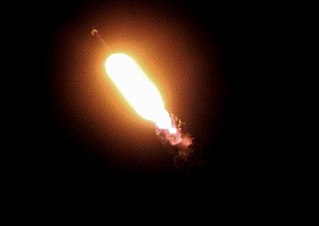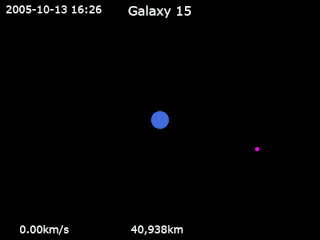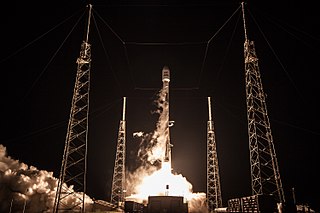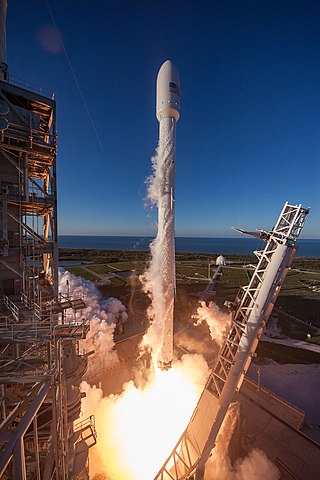
Ariane 5 is a retired European heavy-lift space launch vehicle operated by Arianespace for the European Space Agency (ESA). It was launched from the Guiana Space Centre (CSG) in French Guiana. It was used to deliver payloads into geostationary transfer orbit (GTO), low Earth orbit (LEO) or further into space. The launch vehicle had a streak of 82 consecutive successful launches between 9 April 2003 and 12 December 2017. Since 2014, Ariane 6, a direct successor system, first launched in 2024.

Intelsat S.A. is a multinational satellite services provider with corporate headquarters in Luxembourg and administrative headquarters in Tysons, Virginia, United States. Originally formed as International Telecommunications Satellite Organization, from 1964 to 2001, it was an intergovernmental consortium owning and managing a constellation of communications satellites providing international telecommunications and broadcast services.

SES S.A., trading as SES is a Luxembourgish satellite telecommunications network provider supplying video and data connectivity worldwide to broadcasters, content and internet service providers, mobile and fixed network operators, governments and institutions.
Sirius was a constellation of communications satellites operated at 5.0° East in geostationary orbit (GEO) by NSAB. They carried digital satellite television to the countries of Scandinavia, Baltic states, Eastern Europe and Africa, including the Viasat pay TV system, along with several pay TV packages for Eastern Europe, the TopTV package for Africa, a number of Ukrainian channels and the national Latvian and Lithuanian channel service free-to-air.

SES-8 is a geostationary Communications satellite operated by SES SES-8 was successfully launched on SpaceX Falcon 9 v1.1 on 3 December 2013, 22:41:00 UTC.
AMC-14 is a communications satellite. Initially owned by SES Americom, AMC-14 was designed to be placed in geostationary orbit, following launch on a Proton-M / Briz-M space vehicle. Built by Lockheed Martin and based on the A2100 satellite bus, AMC-14 was to have been located at 61.5° West longitude for Dish Network service.

Galaxy 15 is an American telecommunications satellite which is owned by Intelsat. It was launched for and originally operated by PanAmSat, and was subsequently transferred to Intelsat when the two companies merged in 2006. It was originally positioned in geostationary orbit at a longitude of 133° West, from where it was used to provide communication services to North America.
SES-1 is a geostationary communications satellite which is operated by SES World Skies, then by SES
SES-2 is a communications satellite operated by SES. It was launched alongside the Arabsat-5C satellite.
| SES-3 is a communications satellite operated by SES Americom.
SES-6 is a commercial geostationary communication satellite owned and operated by SES

SES-10, is a geostationary communications satellite awarded in February 2014, owned and operated by SES and designed and manufactured by Airbus Defence and Space on the Eurostar-3000 satellite bus. It is positioned at the 67° West position thanks to an agreement with the Andean Community to use the Simón Bolivar-2 satellite network. It replaces AMC-3 and AMC-4 to provide enhanced coverage and significant capacity expansion.

SES-11 / EchoStar 105 is a geostationary communications satellite operated by SES and EchoStar and designed and manufactured by Airbus Defence and Space. It has a mass of 5,200 kg (11,500 lb) and has a design life of at least 15 years.

SES-12 is a geostationary communications satellite operated by SES.

SES-14 is a geostationary communications satellite operated by SES at 47.5° West, replaces NSS-806, and designed and manufactured by Airbus Defence and Space. The satellite launched on 25 January 2018 at 22:20 UTC along with the Global-scale Observations of the Limb and Disk (GOLD) instrument from NASA. It has a mass of 4,423 kg (9,751 lb) and has a design life of at least 15 years.
SES-16 / GovSat-1 is a geostationary communications satellite designed and manufactured by Orbital ATK; LuxGovSat is a joint venture between SES and the Luxembourg government. It has a mass of 4,230 kg (9,330 lb) and has a design life of at least 15 years. The satellite was launched by SpaceX on 31 January 2018.
AMC-15 is an American communications satellite. Owned by SES Americom, AMC-15 was designed to be placed in geostationary orbit, following launch on a Proton-M / Briz-M space vehicle.

Intelsat 35e, also known as IS-35e is an Intelsat high-throughput (HTS) geostationary communications satellite designed and manufactured by Boeing Satellite Systems on the Boeing-702MP satellite bus. It was launched on 5 July 2017.
SES-17, is a high throughput all electric geostationary communications satellite owned and operated by SES, and designed and manufactured by Thales Alenia Space. Launched on 24 October 2021 from Centre Spatial Guyanais (CSG), in Kourou, French Guiana by an Ariane 5ECA launch vehicle, SES-17 was positioned at 67.1° west in May 2022 and, after testing, became fully operational in June 2022.
SES-4 is a communications satellite operated by SES World Skies.









